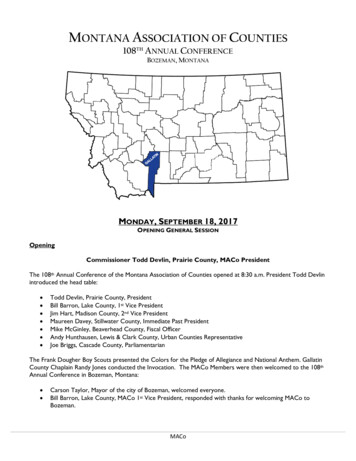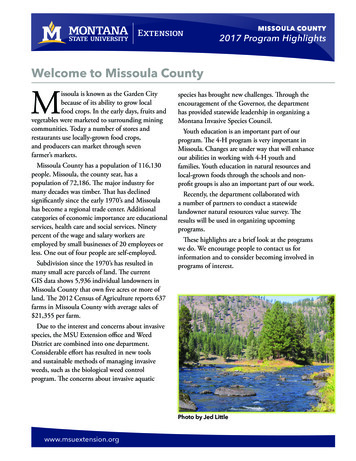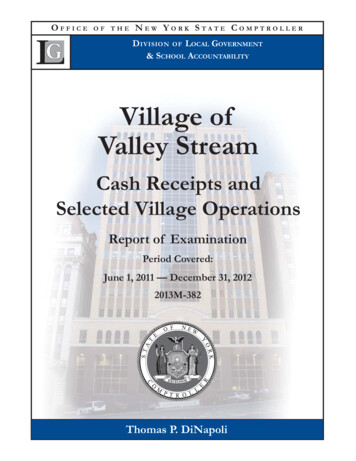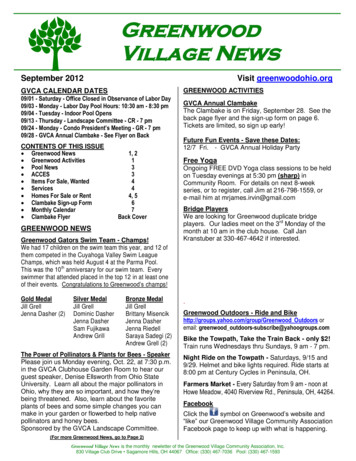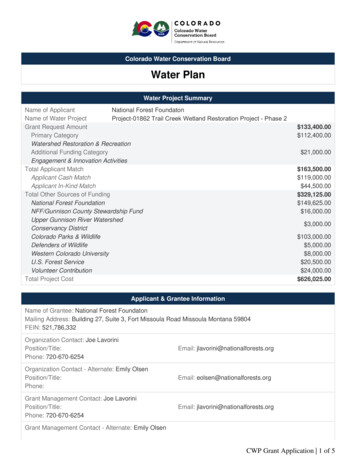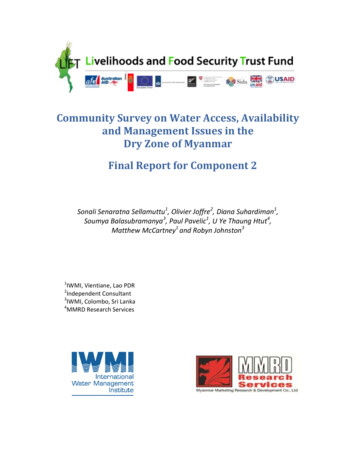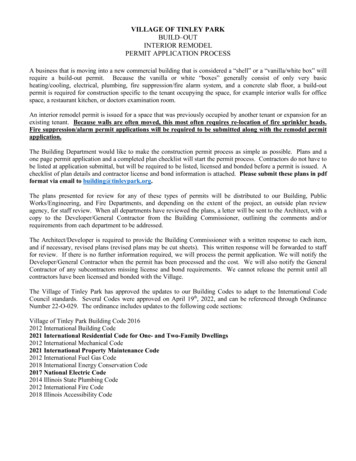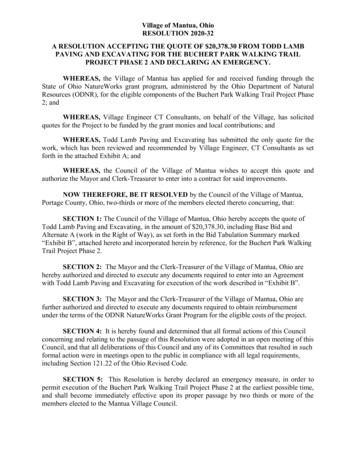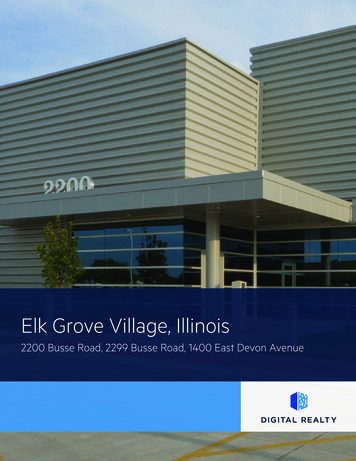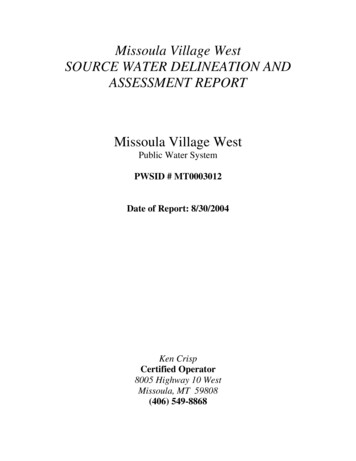
Transcription
Missoula Village WestSOURCE WATER DELINEATION ANDASSESSMENT REPORTMissoula Village WestPublic Water SystemPWSID # MT0003012Date of Report: 8/30/2004Ken CrispCertified Operator8005 Highway 10 WestMissoula, MT 59808(406) 549-8868
Table of ContentsACKNOWLEDGMENTS . IVGLOSSARY. VLIST OF ACRONYMS* . VINTRODUCTION.VIIIBACKGROUND . 9THE COMMUNITY. 9GEOGRAPHIC SETTING . 9GENERAL DESCRIPTION OF THE SOURCE WATER . 9THE PUBLIC WATER SUPPLY . 10WATER QUALITY. 10DELINEATION . 11HYDROGEOLOGIC CONDITIONS . 11CONCEPTUAL MODEL AND ASSUMPTIONS . 13METHODS AND CRITERIA . 13WELL(S) INFORMATION. 13MODEL INPUT. 14TIME-OF-TRAVEL CALCULATION. 14DELINEATION RESULTS . 15LIMITING FACTORS . 15INVENTORY . 16INVENTORY METHOD . 16INVENTORY RESULTS/CONTROL ZONE . 17INVENTORY RESULTS/INVENTORY REGION . 17INVENTORY RESULTS/SURFACE WATER BUFFER ZONES. 17INVENTORY RESULTS/RECHARGE REGION . 17INVENTORY UPDATE . 18INVENTORY LIMITATIONS . 18SUSCEPTIBILITY ASSESSMENT . 19REFERENCES. 21FiguresFIGURE 1 FIGURE 2 FIGURE 3 FIGURE 4 FIGURE 5-MISSOULA VALLEY WEST LOCATION MAPMISSOULA VILLAGE WEST AREA MAPGENERAL SURFICIAL GEOLOGIC MAPGENERAL POTENTIOMETRIC SURFACE MAPGEOLOGIC CROSS SECTION AND HYDROGEOLOGIC CONCEPTUALMODELii
FIGURE 6 FIGURE 7 FIGURE 8 FIGURE 9 -MISSOULA VALLEY WEST INVENTORY REGIONSURFACE WATER BUFFER ZONES AND RECHARGE AREASLAND USE CLASSIFICATIONCONCENTRATION/CLASSIFICATION OF SEPTIC SYSTEMS WITHININVENTORY REGIONFIGURE 10- CONTAMINANT SOURCE INVENTORYTablesTABLE 1. SAMPLE WATER QUALITY DATA FOR THE WYE AREA, MISSOULA COUNTY(WQD, 1996-2003). . 10TABLE 2. WATER QUALITY DATA FOR MISSOULA VILLAGE WEST (MDEQ, PWSANALYTICAL RESULTS, 1995-2001). 10TABLE 3. LIST OF GEOLOGIC OR HYDROGEOLOGIC INVESTIGATIONS FOR THEMISSOULA AREA. . 12TABLE 4. LIST OF GEOLOGIC OR HYDROGEOLOGIC MAPS AVAILABLE FOR THEMISSOULA AREA. . 13TABLE 5. SOURCE WELL INFORMATION FOR MISSOULA VILLAGE WEST PWS. . 14TABLE 6. ESTIMATES OF INPUT PARAMETERS USED TO DELINEATE THE MISSOULAVILLAGE WEST SOURCE WATER PROTECTION AREA. 15TABLE 7. SIGNIFICANT POTENTIAL CONTAMINANT SOURCES FOR PWS #3012INVENTORY REGION . 18TABLE 9. RELATIVE SUSCEPTIBILITY TO SPECIFIC CONTAMINANT SOURCES ASDETERMINED BY HAZARD AND THE PRESENCE OF BARRIERS. . 19TABLE 10. NON-POINT SOURCE RELATIVE HAZARD RATINGS. 19TABLE 11. SUSCEPTIBILITY ASSESSMENT FOR SIGNIFICANT POTENTIALCONTAMINANT SOURCES IN THE CONTROL ZONE AND INVENTORY REGION. . 20AppendicesAPPENDIX A PWS System Layout and Sanitary SurveyAPPENDIX B – Well Logs for PWSAPPENDIX C – MBMG-GWIC Well Logs for AreaAPPENDIX D – Time of Travel CalculationsAPPENDIX E – Inventory SheetsAPPENDIX F - ChecklistAPPENDIX G - Letter of Concurrenceiii
ACKNOWLEDGMENTSThis Delineation and Assessment Report for Missoula Village West PWS (source #03012) wascompleted by Michelle Hutchins, Travis Ross and Jon Harvala, Environmental Health Specialists withthe Missoula Valley Water Quality District. The Missoula Valley is located in Missoula County. Thesystem can be contacted through Russell Rentals (406) 542-0243.iv
GLOSSARYANDLIST OF ACRONYMS*Acute Health Effect An adverse health effect in which symptoms develop rapidly.Alkalinity The capacity of water to neutralize acids.Aquifer A water-bearing layer of rock or sediment that will yield water in usable quantity to a well orspring.AST Aboveground storage tank.Best Management Practices (BMPs) Methods that have been determined to be the most effective,practical means of preventing or reducing pollution from nonpoint sources.Coliform Bacteria Bacteria found in the intestinal tracts of animals. Their presence in water is anindicator of pollution and possible contamination by pathogens.Confined Aquifer A fully saturated aquifer overlain by a confining unit such as a clay layer. The staticwater level in a well in a confined aquifer is at an elevation that is equal to or higher than the base of theoverlying confining unit.Confining Unit A geologic formation that inhibits the flow of water.Comprehensive Environmental Response, Compensation, and Liability Act (CERCLA) Enacted in1980. CERCLA provides a Federal "Superfund" to clean up uncontrolled or abandoned hazardous-wastesites as well as accidents, spills, and other emergency releases of pollutants and contaminants into theenvironment. Through the Act, EPA was given power to seek out those parties responsible for anyrelease and assure their cooperation in the cleanup.Delineation A process of mapping source water management areas.DEQ Montana Department of Environmental Quality.EPA United States Environmental Protection Agency.GWIC Ground-Water Information Center online well database administered by the Montana Bureau ofMines and Geology.Hardness Characteristic of water caused by presence of various chemical compounds. Hard water mayinterfere with some industrial processes and prevent soap from lathering.Hazard A measure of the potential of a contaminant leaked from a facility to reach a public watersupply source. Proximity or density of significant potential contaminant sources determines hazard.v
HazMat Hazardous Materials Response Team.Hydraulic Conductivity A coefficient of proportionality describing the rate at which water can movethrough an aquifer.Inventory Region A source water management area that encompasses the area expected to contributewater to a public water supply within a fixed distance or a specified groundwater travel time.Maximum Contaminant Level (MCL) Maximum concentration of a substance in water that ispermitted to be delivered to the users of a public water supply. Set by EPA under authority of the SafeDrinking Water Act.MGWPCS Montana Ground Water Pollution Control System.MPDES Montana Pollution Discharge Elimination System.NOAA National Oceanic and Atmospheric Administration.Nitrate An important plant nutrient and type of inorganic fertilizer. In water, the major sources of nitratepollution are septic tanks, sanitary sewers, feed lots and fertilizers.Nonpoint-Source Pollution Pollution sources such as stormwater runoff that are diffuse and do nothave a single point of origin or are not introduced into a receiving stream from a specific outlet.NPL National Priority List (Superfund).Pathogens Bacterial organisms typically found in the intestinal tracts of mammals, capable of producingdisease.Point-Source A stationary location or fixed facility from which pollutants are discharged.Public Water System A system that provides piped water for human consumption to at least 15 serviceconnections or regularly serves 25 individuals.Pumping Water Level Water level elevation in a well when the pump is operating.Recharge Region Source water management region that is generally the entire area that couldcontribute water to an aquifer used by a public water system. Includes areas that could contribute waterover long time-periods or under different water usage patterns.Resource Conservation and Recovery Act (RCRA) Enacted by Congress in 1976. RCRA's primarygoals are to protect human health and the environment from the potential hazards of waste disposal, toconserve energy and natural resources, to reduce the amount of waste generated, and to ensure thatwastes are managed in an environmentally sound manner.SDWA Safe Drinking Water Act.vi
Source Water Protection Area For surface water sources, the land and surface drainage network thatcontributes water to a stream or reservoir used by a public water supply.Static Water Level (SWL) Water level elevation in a well when the pump is not operating.Susceptibility (of a PWS) The potential for a public water system to draw water with contamination atconcentrations that would pose concern. Susceptibility is evaluated at the point immediately precedingtreatment or, if no treatment is provided, at the entry point to the distribution system.Synthetic Organic Compounds (SOC) Manmade organic chemical compounds such as herbicides andpesticides.Total Dissolved Solids (TDS) The dissolved solids collected after a sample of a known volume of wateris passed through a very fine mesh filter.Transmissivity The ability of an aquifer to transmit water.Unconfined Aquifer An aquifer containing water that is not under pressure. The water table is the topsurface of an unconfined aquifer.UST Underground storage tank.Volatile Organic Compounds (VOC) Any organic compound that evaporates readily to theatmosphere.MWQA Montana Water Quality Act.WQD Missoula Valley Water Quality District.* Definitions taken from EPA’s Glossary of Selected Terms and /ceisdocs/glossary/glossary.html)vii
INTRODUCTIONThis report is intended to meet the technical requirements for the completion of the delineation andassessment report for the Missoula Village West PWS as required by the Montana Source WaterProtection Program and the federal Safe Drinking Water Act (SDWA).The Montana Source Water Protection Program is intended to be a practical and cost-effective approachto protecting public drinking water supplies from contamination. A major component of the MontanaSource Water Protection Program is termed delineation and assessment. The emphasis of thisdelineation and assessment report is identifying significant potential contaminant threats to publicdrinking water sources and providing the information needed to develop a source water protection planfor the Missoula Village West PWS.Delineation is a process whereby areas that contribute water to aquifers or surface waters used fordrinking water, called source water protection areas, are identified on a map. Geologic and hydrologicconditions are evaluated in order to delineate source water protection areas. Assessment involvesidentifying locations or regions in source water protection areas where contaminants may be generated,stored, or transported and then determining the potential for contamination of drinking water by thesesources.Delineation and assessment is the foundation of source water protection plans, the mechanism theMissoula Village West PWS can use to protect their drinking water source. Although voluntary, sourcewater protection plans are the ultimate focus of source water delineation and assessment. Thisdelineation and assessment report is written to encourage and facilitate the Missoula Village West PWSoperator and the community to complete a source water protection plan that meets their specific needs.viii
CHAPTER 1BACKGROUNDThe CommunityThe city of Missoula is located in the Missoula Basin in the southern end of the Missoula-NinemileValley (Figure 1). The population of Missoula County in 2000 was 95,802 with 57,053 people living inthe city of Missoula (Census 2000). The Bitterroot River enters Missoula from the south and the ClarkFork River enters from the northeast. US Highway 93 serves Missoula from the south and the north andInterstate 90 passes along the northern edge of Missoula (Figure 2). Major Missoula area employersinclude the University of Montana, and the two local hospitals, each employing more than 1000 people.Stimson Lumber operates a lumber and plywood mill in the Bonner area, and employs 450 people. Othereconomic contributors include Smurfit-Stone Container, several transportation companies, as well astourism, small businesses and outlying agriculture and timber operations. Wastewater from much of theCity of Missoula is collected in one sanitary sewer system, undergoes treatment, including biologicalnutrient removal, and discharges into the Clark Fork River near the western edge of Missoula.Surrounding areas, including the Wye, rely on onsite sewage disposal systems. Mountain WaterCompany supplies most City of Missoula residents and businesses with drinking water; much of theoutlying area is served by individual or small public water supply wells.Geographic settingMissoula is located in the southern end of the Missoula-Ninemile Valley as shown in Figure 1. Thevalley elevation ranges from approximately 3000 to 3200 feet above sea level, with surroundingmountain ranges, including the Sapphire Range to the east, the Bitterroot Range to the south, theRattlesnake Range to the north, and the Ninemile Divide to the west, rising to elevations of 5000 to 8000feet. The Clark Fork and Bitterroot Rivers drain the valley; the Clark Fork flows westward through thevalley, and the Bitterroot flows across the southwest corner of the valley, and joins the Clark Fork atKelly Island, approximately 4 miles west of the City of Missoula. Milltown Dam and MilltownReservoir are located approximately 5 miles upstream from Missoula at the confluence of the Clark Forkand Blackfoot Rivers. Rattlesnake Creek was a main source of drinking water until an outbreak ofillness associated with Giardia lamblia in 1983 prompted the local water company to discontinue use ofRattlesnake Creek water and rely exclusively on groundwater from the Missoula Aquifer. The MissoulaAquifer has been designated a “sole-source” aquifer by the United States Environmental ProtectionAgency.The climate in Missoula is typical of western Montana. Missoula receives approximately 13.5 inches ofrain per annum, and 45 inches of snow. The annual average temperature is 44 F with average maximumtemperatures occurring in July (83 F) and average minimum temperatures occurring in January (15 F).General description of the Source WaterThe Missoula Village West wells are completed in the Missoula/Ninemile Valley alluvial aquifer. Theaquifer in the Wye area consists of unconsolidated alluvial fan deposits of gravel and cobbles,interfingered with Glacial Lake Missoula clay and silt, and is recharged mainly from leakage andunderflow from O’Keefe Creek and tributary drainages, and hills flanking the valley.9
The Public Water SupplyThe Missoula Village West PWS is a community water system that obtains water from two wells locatedat 8005 Highway 10 West in Missoula County. The wells draw from approximately 400 feet below theground surface. The Missoula Village West PWS currently serves an estimated population of 68 with26 active service connections. The locations of the wells are shown in Figure 2. The wells are linked to5 captive air tanks, located in the pumphouse, prior to distribution. There is currently no treatmentsystem for the water. A general plan showing the layout of the distribution system is presented inAppendix A, with a copy of the sanitary survey.Water QualityEvery PWS is required to perform monitoring for contamination to their water supply. Water istypically monitored for total coliform and fecal coliform, nitrates, metals and chemicals. Themonitoring schedule depends on the population served, the number of wells and the source water for thePWS. DEQ defines monitoring programs and protocols that are specific to each PWS. There were noreported violations of MCLs listed in the EPA database for Missoula Village West. Table 1 lists typicalconstituents of the Missoula Aquifer, in the Wye area.Table 1. Sample water quality data for the Wye area, Missoula County (WQD, 1996-2003).Sampledate1996 2003(Ave.)Well #/LocationpHWQD # 15, 16,7.238/ 14N20W,Sect. 16, 21 & /L0.0004Table 2. Water quality data for Missoula Village West (MDEQ, PWS analytical results, 19952001).SampleDateWell #/Location1995-2001PWS #3012/(Ave.)14N20W, sect. L)Chloroform(Mg/L)0.1 .0005 .00058.50.530.30.000110
CHAPTER 2DELINEATIONThe source water protection area, the land area that contributes water to the Missoula Village WestPWS, is identified in this chapter. Four management areas are identified within the source waterprotection area: the control zone, inventory region, surface water buffer zone and recharge region. Thecontrol zone, also known as the exclusion zone, is an area at least 100-foot radius around the well. Theinventory region represents the zone of contribution of the well, which approximates a three-yeargroundwater time-of-travel. Analytical equations describing ground water flow using estimates ofpumping and aquifer characteristics and simple hydrogeologic mapping are used to calculategroundwater time-of-travel distance. The surface water buffer zone is delineated based on standarddistance criteria of 10 miles upstream from the ground water inventory zone and encompasses ½ milewidth of land area on each side of the drainages. The recharge region represents the entire portion of theaquifer that contributes water to the Missoula Village West water system.Hydrogeologic ConditionsGeologic and hydrogeologic studies of the Missoula area are listed in Table 3, with a summary of mapslisted in Table 4. The following description is derived from these reports.The Missoula Valley is part of a structural basin that began to open about 65 million years ago, duringthe early Tertiary crustal movement that created the Rocky Mountains. Precambrian metasedimentaryrocks of the Belt Supergroup, and a few interspersed Paleozoic sedimentary rocks surround the valley,with peaks of 5000 to 7000 feet elevation. This relatively impermeable and deeply eroded landscapewas partially filled with Tertiary and Quaternary alluvium, and Glacial Lake Missoula clays and silts.Portions of the Tertiary sediments were scoured from the valley during the repeated draining of GlacialLake Missoula approximately 12,000 to 15,000 years ago, during the Wisconsin glacial stage, and werereplaced with layers of sand, gravel and cobbles, deposited during these catastrophic events and morerecent alluvium deposited along the river channel and flood plain. The sediments generally become finerto the southwest of the valley as a result of dissipating energy after sediment-carrying water flowed outof Hellgate Canyon and across the broader Missoula Valley, depositing coarser sediments first and thengradually allowing deposition of finer sediments.The Missoula Aquifer is semi-confined in this area, and composed mainly of unconsolidated Quaternaryalluvial fan deposits, and Glacial Lake Missoula clay and silt. Layers of clay and silt deposited inGlacial Lake Missoula are interfingered with sand and gravel layers that were deposited between themultiple episodes of draining and refilling the lake. Tertiary deposits (mostly Renova and SixmileCreek Equivalents) flank and underlie the area of Quaternary alluvium, but are generally fine-grainedand much less productive than the more recent deposits. Some wells in the outlying areas of the valleyare finished in Precambrian bedrock, but these are also much less productive than the main waterbearing alluvium, and derive water mainly from fractures. Depth to the water table ranges fromapproximately 6 to 70 feet below land surface, depending on distance from rivers and tributary streams.The seasonal fluctuation of the groundwater table ranges from approximately 2 to 13 feet (Woessner,1988) and depends upon proximity to the recharge source and hydraulic conductivity of the surroundingaquifer sediments. The lateral extent of the Missoula Aquifer varies from about 0.25 miles wide at themouth of Hellgate Canyon, to 6.25 miles wide between Maclay Flats and the mouth of Grant Creek; theoverall length is approximately 20 miles. Groundwater flows generally southwestward through theMissoula Village West area. The aquifer has high source water sensitivity because it is semi-confinedand comprised of unconsolidated material. The Missoula Valley Aquifer has been designated a “Sole11
Source Aquifer” by the U.S. EPA. A geologic map of the Missoula area is presented in Figure 3. Figure4 represents a generalized ground water flow map. Geologic cross sections are shown in Figure 5.Table 3. List of geologic or hydrogeologic investigations for the Missoula area.Title of ProjectRoadside Geology ofMontanaReferenceD. Alt and D.W.Hyndman, 1986Area CoveredMontanaInteractions Between theClark Fork River andMissoula Aquifer,Missoula County,MontanaHydrogeology and waterresources of theMissoula Basin,MontanaGeographic, Geologic,and HydrologicSummaries ofIntermontane Basins ofthe Northern RockyMountains, MontanaK.W. Clark, 1986Missoula ValleyA.L. Geldon, 1980Missoula BasinTo determine thestorage potential of thebasin.Kendy and Tresch,1996.Intermontane basins ofthe northern RockyMountainsGeology and Groundwater Resources of theMissoula Basin,MontanaA Single LayerTransient Flow Modelof the Missoula AquiferMcMurtrey, et. al, 1965Missoula BasinSummarize thegeographic, geologicand hydrologiccharacteristics of theRocky Mountainregion in westernMontana.Summary of geologyand hydrogeologyR.D. MillerMissoula ValleyHydrology and WaterChemistry of ShallowAquifers Along theUpper Clark Fork,Western MontanaThe Source, Fate andMovement ofHerbicides in anUnconfined, Sand andGravel Aquifer inMissoula, MontanaThe Hydrogeology ofthe Central andNorthwestern MissoulaValleyD.A. Nimick, 1993Upper Clark Fork regionM.H. Pottinger, 1988North central MissoulaValleyC.A. Smith, 1992Portion of MissoulaValleyMissoula Valley AquiferStudy: Hydrogeology ofthe eastern portion ofthe Missoula Aquifer,Missoula County,MontanaW.W. Woessner, 1988Eastern portion of theMissoula Aquifer12Project Purpose.Summaries of generalgeology of differentregions in Montana.Define hydrogeologyof Clark Fork Riverand Missoula Aquifer.Computer model todefine groundwaterflow and hydraulicproperties of theMissoula Aquifer.Analyze hydrology ofbedrock andunconsolidatedTertiary andQuaternary depositsHydrologic propertiesand groundwater flowof aquifer to determinesource and fate ofherbicidecontamination.Geology, hydrologicproperties,groundwater flow,interaction with riverand water quality ofthe Missoula Aquifer.To assess existing andfuture anthropogeniceffects on the aquifer
Table 4. List of geologic or hydrogeologic maps available for the Missoula area.Title or DescriptionGeologic Map of theMissoula West 30’ x 60’QuadrangleDate1998Area CoveredMissoula Valley west ofMissoula, and BitterrootValley south toStevensville, MTHellgate Canyon,Missoula CountyPotentiometric Map,March 1993 and June19931994Geologic Map andSections of the BonnerQuadrangle, MontanaGeneralized geologicmap of the Butte 1 X 2degree quadrangle,Montana1961Bonner Quadrangle1987Approximately 100 X70 mi. area of Missoula,Powell, Lewis & Clarkand Deer LodgeCountiesReferenceLewis, R.S., 1998.MBMG Open File 373.Gestring, S.L., 1994.The Interaction of theClark Fork River andthe Hellgate Valley onthe Aquifer NearMilltown, MTNelson and Dobell,1961Wallace, C.A., USGSMiscellaneous FieldStudies Map MF-1925Conceptual Model and AssumptionsA conceptual hydrogeologic model is a simplified representation of the hydrogeologic system. Thissection describes the conceptual model used for this report.The ground water in this part of the Missoula Valley is generally semi-confined under discontinuousGlacial Lake Missoula silts and clays, and occurs primarily in unconsolidated Quaternary sand andgravel alluvial fan deposits, which are laterally and basally bounded by much less permeable tertiarysediments and bedrock. Tertiary sediments and fractured bedrock yield small quantities of water in someareas. Recharge in this area is derived mainly from leakage and underflow from tributary drainages, andhills flanking the valley. Ground water flows generally southwestward through the Wye area (Figure 5).Methods and CriteriaThe Montana Department of Environmental Quality specifies the methods and criteria used for sourcewater protection zone delineation for the Missoula Village West PWS (DEQ, 1999). Because the upperClark Fork alluvial aquifer communicates with the Clark Fork River and communicates with tributarystreams in the area, Surface Water Buffer Zones were applied to the Clark Fork River and tributarydrainages. Time-of-travel calculations were completed for the ground water system using the uniformflow equation (U.S.E.P.A. 1991). Using published reports, estimates of the aquifer properties weremade and are discussed in the following section. The recharge area is defined as the area where theaquifer is present upgradient from the well(s). The surface water buffer zones were delineated based onstandard distance criteria of 10 miles upstream from the ground water inventory zone and encompassed½ mile width of land area on each side of the drainages.Well(s) InformationThe wells are located at 8005 Highway 10 West, in Township 14 North, Range 20 West, section 28, inMissoula County. Well 003 is currently not being used and is disconnected from the distributionsystem. Table 3 is a summary of the wells information and Appendix B contains copies of the well logs.The one well for which we have records is drilled to a depth of 400 feet.13
Table 5. Source well information for Missoula Village West PWS.InformationPWS Source CodeWell Location(T, R, Sec or lat, long)MBMG#Water Right #Date Well was CompletedTotal DepthPerforated IntervalStatic Water LevelPumping Water LevelDrawdownTest Pumping RateSpecific CapacityWell #1Well #2(Disconnected)003012-002Well #30003012 -002, -003, -004Lat: 46.9468 Long: - 114 .1329 171795----------Lat: 46.9491 Long: - 114 .1336 163017-7/30/97400 ftOpen Bottom178.00 ft304.5 ft126.5 ft60 gpm0.5 gpm/ftModel InputTime-of-travel input values are conservative assumptions made to identify areas that potentially impactsource water for the Missoula Village West PWS. The criteria for selection of each value used for thisdelineation is summarized as follows:Thickness: The thickness of the aquifer is estimated to be 15 ft, inferred from area well logs.Hydraulic Conductivity: A value for hydraulic conductivity is estimated to be 300 ft/day, based uponSmith (1992) and typical hydraulic conductivities of moderately sorted unconsolidated deposits (Freezeand Cherry, 1979). We have chosen a value that should provide a conservative estimate of time-oftravel distances.Transmissivity: The estimated value for transmissivity in this area is 4500 ft2/day (T Kb, where K hydraulic conductivity 300 ft/day; b aquifer thickness 15 ft).Hydraulic Gradient: The estimated hydraulic gradien
This Delineation and Assessment Report for Missoula Village West PWS (source #03012) was completed by Michelle Hutchins, Travis Ross and Jon Harvala, Environmental Health Specialists with the Missoula Valley Water Quality District. The Missoula Valley is located in Missoula County. The system can be contacted through Russell Rentals (406) 542 .
